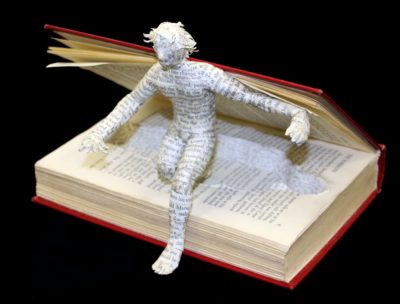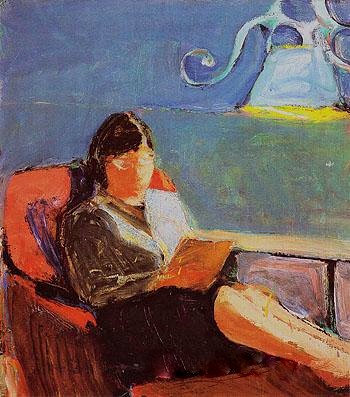David Lusk, Figure in a Book After, circa 2010.
down with users, up with readers: a provocation on digital humanities reception.
The task of naming belongs to every reader. — Albert Manguel
One shift in the digital humanities that needs more attention is the changing, often contested, understanding of audience: who are “they,” the people one hopes will receive a project, a post, a game, an archive, an interactive experience? Who lies on the other side of the search box? Who clicks the link? How do makers wish to treat their audiences? Should we even conceptualize them as audiences anymore? Should they be reconstituted as fellow makers? As active respondents? As curious surfers across the platform? As bits of code entered into the project’s very DNA? As passive distributed networks of collective computation? Some combination of all of those?
And how many of those audience members are there, anyway? Do they even have to be human, or should we also include bots and AI algorithms? Does a successful digital humanities project require a mass audience? Or might it be acceptable to picture what Gary Alan Fine refers to as “tiny publics” as perfectly suitable “users” of digital humanities endeavors? Who is the audience, exactly, for the digital humanities, and what should they look like, be like, act like?

Joseph Cornell, Untitled (To Marguerite Blachas), circa 1939-1940.
So much attention has been focused on digital humanities scholarship itself—what it should consist of, how it should work, what the rules are for evaluating its worth should be—that the danger is to lose sight of the reception of digital humanities work. What we might think of as the ontological status of digital humanities projects and products has trumped the question of who the work is for, and why (“hey, that’s not a book and two articles, so no tenure for you!” or, alternatively, “hey, this new being in the world—the Virtual Insert-the-Blank—utterly revolutionizes how we might know the world”).
Of course, that’s not entirely true. For what the digital humanities becomes as created entities is deeply informed by who makers are imagining might use these new modes of scholarship. Yet despite all the supposed analytics of use produced in the digital domain, we really still know little about the experience of digital humanities work.
The danger is that the digital humanities replicates the intense focus on producing a new kind of consumer as occurs in the domain of Silicon Valley products (Google, Apple, etc.). In that world, much creativity revolves around imagining, researching, and formulating a new persona out of technological acts of engineering. A new kind of person, a new subject, a new “user” is being projected on us, generated in us, promulgated through us, every time we search, click, post, browse, download, upload, save, delete. In the digital humanities world, broadly conceived, there has been some attention to challenging this protocol and questioning its underlying assumptions about audience. Postcolonial digital humanities, feminist digital humanities, and other modes of cultural criticism push questions of product and process in relation to audience from the margins to front and center.
But even in these works, the question for the digital humanities remains whether its practitioners wish to replicate the Silicon Valley notion of the “user” or strive for overlapping, alternative, or even oppositional framings of the persona and subject who arrives at, receives, contributes to, and uses digital humanities projects. How, in other words, do we name the audience member, both as individual and en masse? Who are the digital humanities users as a whole and how might we think of the digital humanities user as an ideal type?
Perhaps it is that very word—user—that might be worth rejecting here. What if digital humanities projects jettisoned the term, with its shadings of addiction and compulsion, of a debased sort of exchange? So much effort in the digital humanities has gone toward overthrowing older notions of reading (moving from close reading to distant reading being among the most controversial), have we tossed out the figure of the reader too? Have we gone from the death of the author to the death of the reader?
What if we have it backward? Instead of killing off reading, and the reader with it, what if digital humanities practitioners consciously resist using “the user”? What if we put aside this name both for imagining audiences and working with them as real people? What if digital humanities focuses on extending, enriching, enhancing what it means to read and to be a reader?
Richard Diebenkorn, Woman Reading, 1959.
Many projects are doing just this in practice. They seek to reinvigorate what the act of reading entails, and by extension what it means to identify as a reader. They dream of more active, critical modes of reading. Or they question the boundary between human reading and machine reading. Or they attempt to draw in new audiences, previously marginalized, through different approaches to what it means to read. Or they hope to call into being an audience of “general readers,” a public of smart, attentive, creative receivers and respondents. Digital humanities projects of a righteous nature hope to support a democracy of reading and readers.
And yet there is a steady shift toward adopting the computer industry’s imagining of audiences as “users” rather than readers. Maybe digital humanities scholars should stop that shift in its tracks. Maybe the digital humanities should place reading and the reader at the center of things more explicitly.
What would it mean to offer a more expansive understanding of reading and the reader? Beyond dark sides of the digital humanities or the dazzling spotlights of attention and acclaim, the reader is out there in the shadows, eyes at the dim glow of the screen, tablets at the ready, monitors humming, device in hand, fingers on the pulse. We should neither use this figure nor let readers be used anymore. We should let them be readers.


Thank you for this Michael. I completed a PhD dissertation last year on narrative and interactive digital texts, and in doing so I made an effort for the “extending, enriching, enhancing what it means to read and to be a reader”. You and your readers may be interested in it:
http://umu.diva-portal.org/smash/record.jsf?pid=diva2%3A810640&dswid=5678